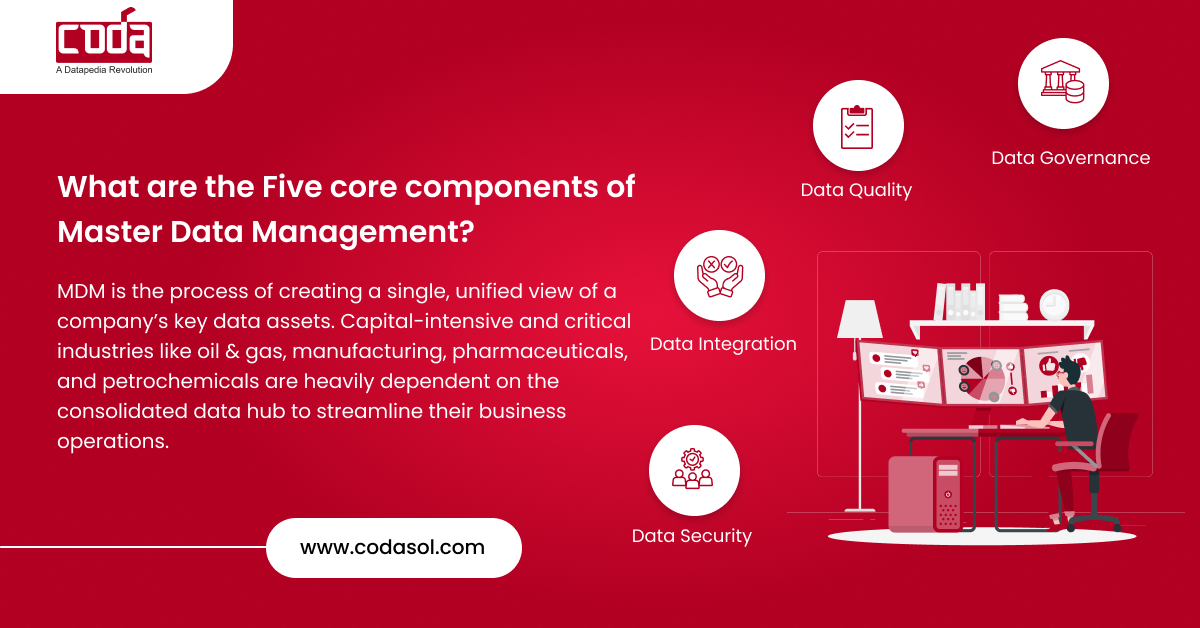Master data management (MDM) is a critical component of any organization’s data management strategy. At its core, MDM is the process of creating a single, unified view of a company’s key data assets. This unified view is used to support a wide range of business processes, including data governance, data quality, data integration, data security, and data analytics.
In this post, we will discuss the five core components of master data management
Data Governance:
Data governance is a critical function of master data management (MDM) and establishes roles and responsibilities for data management, setting data quality standards, and monitoring data to ensure compliance with these standards.
Data governance establishes a clear set of policies and procedures that govern how data is created, used, and maintained within the organization. It includes defining the roles and responsibilities of different stakeholders, such as data owners, data stewards, and data users. It also includes setting guidelines for data quality, such as ensuring that data is accurate, complete, and consistent across different systems and applications.
Another important aspect of it is performing regular audits and assessments of data quality, as well as implementing automated tools and processes to detect and correct data errors.
It also covers data lineage, which is the process of tracking the movement of data through the organization by identifying where the data came from, who has access to it, and where it is being used. This information is critical for understanding the context and accuracy of data, and for identifying any issues or errors.
Data Quality:
Data quality identifies and removes duplicate data. It is vital because duplicate data can lead to inaccuracies and inconsistencies, which can impact the quality of data, and make it difficult to make business decisions.
MDM tools like Prosol and techniques such as data matching and data deduplication can be used to identify and remove duplicate data, ensuring that the data is accurate and consistent.
Data quality also involves standardizing data formats. It includes ensuring that data is entered in a consistent format across different systems and applications, properly coded and labeled. It helps to ensure that data is accurate, consistent, and can be easily understood and used by stakeholders.
Data validation is also a vital aspect of data quality. It ensures data is accurate and complete and conforms to established data quality standards manually or through automated tools, such as data validation software.
It is essential for maintaining the trust of customers and partners and for making informed business decisions. Inaccurate or incomplete data can lead to costly errors and can negatively impact an organization’s reputation.
Data Integration:
The process of consolidating data from different systems and applications, such as ERP and CRM systems is Data Integration. Techniques like Data mapping, data federation, and data replication can be used to consolidate data from different systems and applications.
It collects and integrates data from external sources, such as social media, market research, and weather data. It helps to provide a complete view of the organization’s data and can help to uncover new insights and trends. Data integration is also important for data governance and data quality.
Data integrity goes beyond data quality. It determines whether the quality of data can be trusted or not. It inspects the reliability of the entered data and maintains consistency to stay up-to-date.
Data Analytics:
Data analytics helps uncover insights and trends in the data using data mining and machine learning techniques to identify patterns and relationships in the data. These insights can be used to identify new opportunities, optimize business processes, and improve customer engagement. Techniques like data warehousing, data mining, and analytics platforms can perform data analytics.
Data analytics is advanced analytics with predictive modeling and data visualization. Predictive modeling uses statistical techniques to make predictions about future events, while data visualization is the process of creating visual representations of data to help users understand and interpret the data.
These advanced analytics techniques help organizations by providing an in-depth understanding of the data, which can help to identify new opportunities, optimize business processes, and improve customer engagement.
Data Security:
Data security helps to protect the data from unauthorized access by implementing access controls and authentication mechanisms to ensure that only authorized users can access the data and prevent potential security breaches. Firewalls, intrusion detection systems, and security information and event management (SIEM) can be used to protect the data from unauthorized access.
It ensures compliance with data privacy regulations by implementing processes and controls to protect sensitive data, such as the personal data of customers and employees, and responding to data breaches in compliance with regulations under the General Data Protection Regulation (GDPR).
Data encryption is also an important aspect of data security. It converts plain text data into a code that can only be deciphered with a specific key or password. It helps to protect sensitive data, such as financial information, personal data, and other confidential information, and is essential for maintaining the trust of customers and partners.
To be effective, all these five core functions of MDM – data governance, data quality, data integration, data analytics, and data security must be a collaborative effort involving all stakeholders across the organization including IT, business, and legal teams working together to establish data security policies, as well as regularly reviewing and updating these policies to reflect changes in the organization and new data privacy regulations.
These five core components are essential for creating a single, unified view of a company’s key data assets and ensuring that this data is accurate, complete, and consistent.
By implementing MDM tools like Prosol, organizations can improve data quality, make better business decisions, and protect sensitive information

